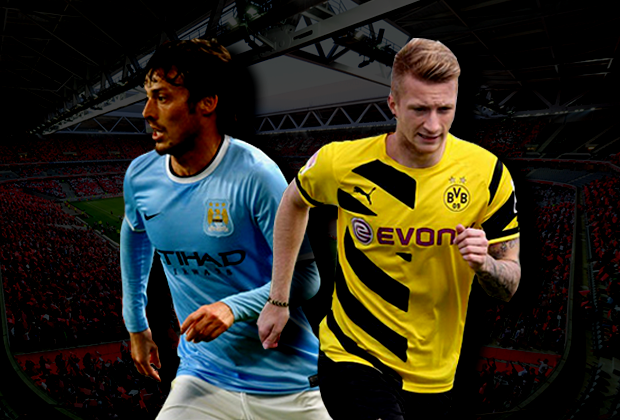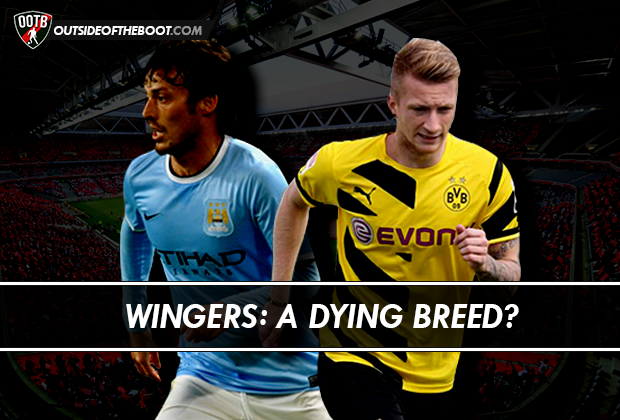If you look back at some of the great sides of the late 90’s and early 2000’s, they all utilised out and out wingers. The 1997/98 Arsenal side had Marc Overmars, whilst Manchester United’s treble winning side had Ryan Giggs and David Beckham running the flanks. Further abroad, Luis Figo played as a winger for both Real Madrid and Barcelona. All of these players were the type of wingers who would hug the touchline on the side of their favoured foot, and either beat their man and cross from the byline or swing in early crosses for the striker. However, in the last 5 years or so, this type of winger has diminished, and although their are some exceptions, such as Juan Cuadrado, players like this are more of a rarity these days.
It’s hard to put the decline of old fashioned wingers down to one point. However, there have been changes in the modern game that are definitely factors. Modern full backs are becoming more and more attacking, with the attacking side of their game now being equally important as the defensive. Players such as the Barcelona duo of Dani Alves and Jordi Alba often make overlapping runs down the touchline, and to create space for these runs, wide midfielders often have to move inside, instead of also hugging the touchline like traditional wingers.
Another reason is the increased emphasis on possession football. Teams such as Barcelona and Arsenal have always prioritized possession football, but in recent years, more teams have also started to play a style of play that involves retaining possession. Due to this, wide midfielders are often required to play narrower in order to strengthen the centre of the team and help retain possession, rather than offer a more direct approach out wide.
But that isn’t to say that wide men have been banished from the beautiful game. We do see them operating even today, just in different roles.
Inside Forwards
The most common role of wide players these days is that of the inside forward. Like traditional wingers, their starting position is often by the touchline. However, the difference comes when they are in possession of the ball. Whilst conventional wingers will continue to hug the touchline and try to get a cross in from out wide, an inside forward will instead pick the ball up and cut inside onto their stronger foot, before either having a shot at goal or playing a through ball to a striker, overlapping full back or midfielder. Two perfect examples of the recent rise in prominence of this role are Cristiano Ronaldo and Arjen Robben, arguably the two best wingers in the world. Ronaldo and Robben, when at Manchester United and Chelsea respectfully, played on the side of their favoured foot, and used their pace and dribbling skills to skin opposition full backs and get to the byline.
However, when they both left the Premier League, their styles changed drastically, as they switched to opposite flanks.. Now, with Ronaldo at Real Madrid, and Robben at Bayern, both of them or renowned for cutting inside on their stronger foot and releasing a ferocious shot on goal. Whilst this is now often quite a predictable move, particularly from Robben, it is extremely difficult to prevent against such a skillful player, and the fact that the two best wide midfielders at the moment are both inside forwards emphasises the effectiveness of the role in the modern game. Marco Reus and Gareth Bale have also made a name for themselves playing in this role.
Wide Playmakers
These players usually tend to be natural players in the “number 10” role who have been shipped out wide due to the lack of that position in a particular formation. Unlike winger and inside forwards, they tend to position themselves narrower both with and without the ball. They usually lack the pace and shooting of most wingers and inside forwards, but more than make up for it with their ability to unlock a defence with an excellent pass. For this role, the best example is Mesut Ozil. He played as the number 10 in a 4-2-3-1 at Real Madrid, and was one of the best in the world there. However, when he joined Arsenal in September 2013, he was quickly deployed on the left flank, due to Arsene Wenger’s insistence on playing a 4-3-3 with one defensive midfielder and two central midfielders.
Despite having a promising start, Ozil began to struggle, and Wenger was criticised for playing him on the left. This is prove that it can be a poor position for a natural playmaker as they can easily become isolated. However, there are also examples of players who have excelled in the role, such as Koke at Atletico Madrid, who plays on the left of a 4-4-2, and managed to get 13 assists and 6 goals from that position in the 2013/14 season. His form has continued this season, and he currently has 8 assists and 2 goals and 22 games. David Silva is another fine example of such a player.
Will the traditional winger return?
Football is an ever changing, unpredictable game, which is what makes it so exciting. It also means that it’s entirely possible that the role of the traditional winger will become more common in the game again, sooner or later. With the rising prominence of formation utilizing 3 central defenders and no full backs, the wings in matches will become more exposed again, and this is the area in which traditional wingers could become very effective again. Until then, I’m sure there are an adequate amount of youtube montages of Luis Figo and David Beckham marauding the flanks, terrifying opposition full backs.
Written by Finley Crebolder
- Does Marco van Ginkel have a future at Chelsea? - July 21, 2016
- Rafael van der Vaart: How does he fit into Betis’ tactical plans? - September 23, 2015
- Derlis Gonzalez, David Ospina and more – 4 Players who defined the Copa America 2015 quarters - June 29, 2015

























































